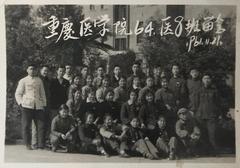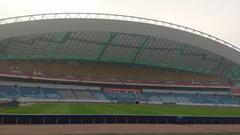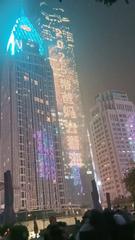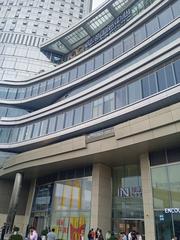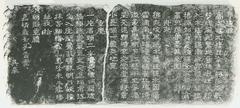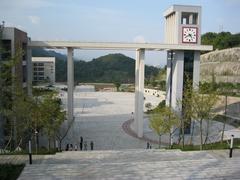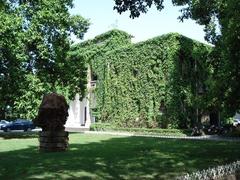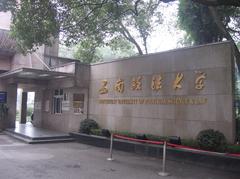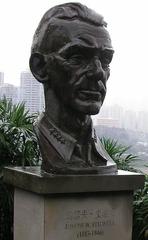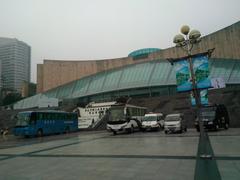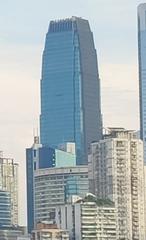Tuanjiecun Railway Station Visiting Hours, Tickets, and Travel Guide: Chongqing Historical Sites
Date: 04/07/2025
Introduction
Tuanjiecun Railway Station, set in Chongqing’s bustling Shapingba District, is a testament to the city’s transformation from a rural outpost to a vital link in China’s global logistics network. Once a modest village stop, Tuanjiecun has evolved into a pivotal freight and logistics center, connecting western China to Europe, Southeast Asia, and beyond. Its strategic location within the Chongqing International Logistics Hub Park integrates the ancient Silk Road Economic Belt with the Yangtze River Economic Belt, anchoring the city’s role in Eurasian trade (ichongqing.info; chinadaily.com.cn; SCIO, 2024).
Primarily a freight terminal, Tuanjiecun is not a standard tourist destination, but it offers unique opportunities for those interested in industrial tourism, railway heritage, and modern logistics. Its proximity to cultural landmarks like Ciqikou Ancient Town and the Dazu Rock Carvings further enhances its appeal (Xinhua, 2024; People’s Daily).
This in-depth guide explores Tuanjiecun Railway Station’s history, evolution, operational highlights, visitor policies, and its importance as a linchpin in the Belt and Road Initiative. Whether you’re a logistics professional, history buff, or adventurous traveler, this resource is designed to maximize your experience and understanding of Tuanjiecun’s significance in global trade.
Historical Overview
From Rural Outpost to International Hub
Tuanjiecun Railway Station, literally “United Village,” began as a minor rural stop staffed by just 20 employees, with basic infrastructure and limited passenger and freight capacity (ichongqing.info). Despite its modest origins, its strategic location laid the groundwork for future growth as Chongqing’s urban landscape expanded.
Milestone: China-Europe Freight Train
The station’s international profile soared in March 2011 with the launch of the first China-Europe freight train (Yuxinou), connecting Chongqing directly with Duisburg, Germany (chinadaily.com.cn). This milestone positioned Tuanjiecun as a flagship node within the Belt and Road Initiative, transforming it into a vital link between Asia and Europe.
Rapid Modernization
Following the success of the China-Europe Railway Express, Tuanjiecun underwent rapid expansion. The station area grew to over 2,000 mu (133 hectares), equipped with advanced container handling systems and a workforce of more than 800 (lmcchina.org). Today, it is Chongqing’s largest container hub, handling up to 700,000 TEUs annually and designated as an international first-class station (chinadaily.com.cn).
Visiting Tuanjiecun Railway Station
Visitor Access and Guided Tours
- Hours: The station operates 24/7 for freight; public access is highly restricted. Industry professionals, students, or special groups can request guided tours, which must be arranged in advance with local authorities or logistics companies.
- Tickets: There are no regular passenger services or ticket sales at Tuanjiecun. All passenger train tickets should be purchased at Chongqing’s main passenger stations.
- Guided Tours: Subject to approval and availability, guided tours offer a behind-the-scenes look at modern logistics operations and the station’s history.
- Accessibility: The station is equipped with ramps, elevators, and bilingual signage to support visitors with mobility needs. However, access to operational areas is limited for safety.
- Photography: Exterior photography is generally allowed; interior and operational areas require special permission.
Transportation to the Station
- Metro: Chongqing’s advanced metro network connects most districts. While Tuanjiecun is not a passenger hub, nearby stations and bus lines provide access to the Shapingba District (China Xian Tour).
- Taxi/Ride-hailing: Taxis and ride-hailing apps are convenient, with fares from the city center typically 60–80 RMB.
- Buses: Numerous bus lines serve the district, with transfers possible using the Chongqing Transportation Card.
Station Facilities and Logistics Infrastructure
Layout and Operations
- Scale: Over 2,000 mu, with 12 arrival and departure lines and specialized container handling areas (Wikipedia).
- Cargo Handling: Advanced gantry cranes, container yards, and refrigerated zones support a wide range of goods, including electronics, vehicles, and perishables (People’s Daily).
- Customs and Bonded Zones: On-site customs operate 24/7, with bonded warehousing allowing efficient import/export processing (iChongqing).
- Multimodal Connectivity: The station integrates rail, road, and river transport, connecting to the China-Europe Railway Express and the New International Land-Sea Trade Corridor.
Services
- Logistics Companies: Firms like Yuxinou Supply Chain Management coordinate freight movement and customs (iChongqing).
- Technology: Advanced IT systems provide real-time tracking and digital customs clearance.
- Visitor Amenities: Dining and accommodation are limited near the station; most visitors stay in central Chongqing.
Nearby Attractions and Cultural Sites
- Ciqikou Ancient Town: Historic riverside community with preserved Ming and Qing architecture, teahouses, and artisanal shops.
- Dazu Rock Carvings: UNESCO World Heritage Site featuring intricate Buddhist sculptures.
- Jiefangbei CBD: Chongqing’s commercial core, offering shopping and modern city life.
- Three Gorges Museum: Exhibits on the Yangtze River’s history and the area’s cultural heritage.
- Hongya Cave: Iconic stilted buildings and vibrant night markets on the Jialing River.
Travel Tips
- Advance Arrangement: If you wish to tour the station, contact logistics companies or local authorities well in advance.
- Safety: Adhere to safety regulations and restricted zone policies during visits.
- Language: Bilingual signage and English-speaking staff are available, but a guide or interpreter is helpful.
- Best Times: Avoid rush hours for easier transportation and less congestion.
- Weather: Prepare for Chongqing’s humid subtropical climate; dress accordingly if touring outdoor areas.
Frequently Asked Questions (FAQ)
Q: Can tourists visit Tuanjiecun Railway Station?
A: Only by prior arrangement via logistics companies or local authorities; it is not a public tourist site.
Q: Are there passenger train services at Tuanjiecun?
A: No regular passenger trains. Use Chongqing’s main passenger stations for travel.
Q: Are guided tours available?
A: Occasionally, for industry professionals, students, or special groups.
Q: Is the station accessible for disabled visitors?
A: Yes, but mobility within operational areas is limited and supervised.
Q: Can I take photos inside the station?
A: Exterior photography is permitted; interior photography requires permission.
Summary and Travel Recommendations
Tuanjiecun Railway Station is a model of China’s rapid economic growth and international logistics innovation. As a key hub in the Belt and Road Initiative and the New International Land-Sea Trade Corridor, it exemplifies the synergy of advanced infrastructure, resilient supply chains, and cross-border collaboration (SCIO, 2024; People’s Daily).
While access is restricted, guided visits offer an educational glimpse into cutting-edge freight operations. Combine your visit with Chongqing’s nearby historical and cultural sites for a comprehensive exploration of the region’s past and present.
Plan ahead, respect operational protocols, and immerse yourself in the dynamic story of Tuanjiecun—where ancient trade routes meet modern logistics.
Official Sources and Further Reading
- ichongqing.info
- chinadaily.com.cn
- SCIO, 2024
- Xinhua, 2024
- People’s Daily
- iChongqing
- iChongqing Guide
- Wikipedia (Chinese)

